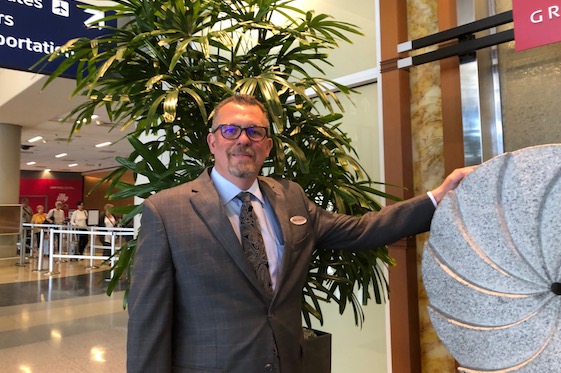“The only disadvantage to running an airport hotel is lack of longer-stay guests,” says Keith Spinden, general manager of the Grand Hyatt DFW at Dallas/Fort Worth International Airport in Texas.
The Grand Hyatt DFW was built as part of the airport’s Terminal D, which opened in 2005. The 298-room hotel is, indeed, part of the terminal: It rises nine floors above the main concourse and is easily reached from arrivals and departures levels, and from the driverless Skylink train that connects the airport’s six terminals.

There are constant check-ins, and check-outs – as is typical with airport hotels, average stay is just under 1.3 nights. “We have arrivals at all hours when flights operate, which is 5 a.m. through to midnight,” explained Spinden. Take the dedicated escalator up from departures direct to hotel reception. There, the area has a monitor alerting you to what time flights are leaving and for where. There, too, is a large wall-set video screen with continually changing promotional images for tempting culinary dishes.
Food is taken extremely seriously at this hotel, which consistently ranks top of all 198 properties on or within immediate range of the airport. Arrive early morning and go straight in to restaurant breakfast and it is quite likely you might be
brought a pre-taste, with the chef’s compliments, of, say, a miniature Texas-style one-bite steak and a quail egg. Culinary reputation helps bring back the 33% of hotel guests who are repeats (at least 5% return around once a month).
The reputation is boosted by a traditional executive chef, Jean-Claude Plihon from Dinard, France, and by the fact that the GM came up via F&B. After graduating from the Culinary Institute of America in Hyde Park, New York, Spinden joined Hyatt in 1987. He worked his way up the cooking ladder to be executive chef of Hyatt Regency Maui Resort and Spa, and in 2000 he evolved to mainstream operations. He moved to his current hotel in 2015 after running Hyatt Regency Indianapolis, connected to that city’s busy convention center.
When it comes to filling hotel beds, about half of those staying over are on leisure, primarily before or after a vacation (there are attractive seven- and 14-night carpark packages). The other 50% are here for meetings, in the hotel or in Dallas or Fort Worth. These meetings are booked up to 24 months out, typically 30 to 50 participants in the 33-to-50-year-old age group. The rooftop 24/7 Precor gym is, like culinary, a big draw, whereas its adjacent outdoor pool is not. All this resulted in 2018 average occupancy of lower 80s.
“Looking back, my biggest achievement since arriving here is that, with the support and commitment of my fantastic team, we have been ranked #1 by guests for customer service among all Grand Hyatt hotels, globally, for the last four years. Now if only we could get them to stay longer than 1.3 nights,” he mused.
His 300-strong team, which has an annual turnover of just over 20%, is culled from neighboring counties all around the airport: Average commute time is 20 to 30 minutes and they have free airport parking. “Looking ahead to the next four years, our biggest challenge will be staffing. Significant growth in the Dallas/For Worth metroplex, paired with near- historical lows in unemployment generally, are creating an imperfect staffing storm. This requires creativity to stand out among a sea of employers,” Spinden said.
